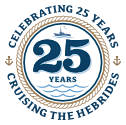 The group of four idyllic Hebridean islands know as “The Small Isles” is located south of the Isle of Skye. The best way to get a feel for these delightful islands is to island-hop to each one from the sea. The Isles of Canna, Rum, Eigg and Muck are each totally different from its neighbour, all with tiny populations, each with its own fascinating culture and history. The scenery, serenity, history and wildlife on a journey through these islands are remarkable. And wherever you are, there are breathtaking vistas of the inner and outer Hebridean islands.
The group of four idyllic Hebridean islands know as “The Small Isles” is located south of the Isle of Skye. The best way to get a feel for these delightful islands is to island-hop to each one from the sea. The Isles of Canna, Rum, Eigg and Muck are each totally different from its neighbour, all with tiny populations, each with its own fascinating culture and history. The scenery, serenity, history and wildlife on a journey through these islands are remarkable. And wherever you are, there are breathtaking vistas of the inner and outer Hebridean islands.
The community-owned Isle of Eigg is the most populated island with around 100 residents. The smallest is the Isle of Muck , owned by the McEwen family for over 100 years with a population of around 40. The largest island is the Isle of Rum, part owned by a community of 45 people and Scottish Natural Heritage. Canna, owned by the National Trust for Scotland is the furthest outlying island, with a population of only 12.
While cruising these islands we regularly see several species of dolphin, seals and porpoises. From July onwards basking sharks and Minke whales visit these waters. The islands are famed for their rich archeological heritage and their geology; the Small Isles are part of the Lochaber Geopark.
Eigg is dramatically dominated by the towering ridge of “An Sgurr” with the opportunity for a guided walk for those willing to give it a try. Laig bay, a large white Atlantic beach, faces the Cuillins of Rum, one of the most memorable views on the west coast of Scotland. Further North is the Singing Sands, a stunning musical quartz beach surrounded by outstanding geological formations. For such a small island there is plenty of rare wildlife including Eagles. Eigg is an important breeding site for Manx Shearwaters which leave the nest in July.
Canna has a wild and remote beauty and is rightly known as the “Jewel of the Hebrides”. It has an amazing diversity of wildlife on its coasts and woodland and is a bird sanctuary with over 155 different species monitored annually. It is perfect for walking, offering easy short trips up Compass Hill or for more longer walks to the West side of the Islands with great archeological sites to visit.
Muck is the most fertile of the Small Isles, and is important for migratory birds. The island population lives mainly round the tiny harbour of Port Mor where the horse shoe anchorage is very picturesque and accessible to the shore. On the farm, there are hairy Luing cattle, a range of breeds of sheep, pigs, hens, and Highland ponies, with three brood mares and the impressive stallion, Strathmashie Seumas Mhor.
Rum’s rugged mountainous landscape offers great opportunities for walking. We recommend the guided tour to Kinloch Castle and a visit to the excellent otter hide. Rum has a wide variety of natural habitats, is famous for its red deer herd, eagles and is also an important breeding site for Manx Shearwaters.
As we cruise the Small Isles, ever present on the horizon is the amazing vista of the Cuillin Mountain Range. Eventually, the promise is too much and we have to leave these delightful small islands to complete a magical journey, over the sea to Skye.























What an amazing trip! We were aware that there were no guarantees for anchoring off St Kilda or indeed of going ashore but thanks to the expertise and care of James and his crew we made it, and goodness aren't we appreciative. It was a truly memorable and special experience. Lucy Mary accommodated us beautifully. The professionalism, genuine enthusiasm and hard work by all the crew made our trip the best it could possibly be. The catering, wildlife spotting, walks ashore were excellent and each member of the crew played their part in making it so. This was our second holiday with Hebrides Cruises and we would certainly do another!
Jane Hunter: 2 June 2025St Kilda and the isles of the Outer Hebrides